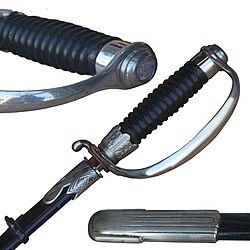Degen (SS)
| SS-Ehrendegen | |
|---|---|
 Three views of a Degen: top, the SS sign on the pommel; middle, the oak leaves and the runic design of the handle and upper scabbard; bottom, the art deco tip of the scabbard | |
| Type | Sword |
| Place of origin | Peter Dan. Krebs firm of Solingen, Germany |
| Service history | |
| Used by | Schutzstaffel |
| Wars | World War II |
| Production history | |
| Produced | c. 1936 - 1945 |
| Specifications | |
| Blade type | Single-edged, straight bladed. |
The SS-Ehrendegen, also SS-Degen (officially Ehrendegen Reichsführer-SS[1]), was a straight sabre or sword, especially of the dress sword worn with a Schutzstaffel (SS) uniform from 1935 until 1945.
First introduced in 1935, it was designed by Professor Karl Diebitsch, an SS-Oberführer, who was also Heinrich Himmler's personal referent on all art and design within the SS. The degen was originally manufactured by the Peter Dan. Krebs firm of Solingen, Germany.[2]
Description

It had a long thin straight blade produced at different lengths to accommodate for the height of the wearer. The degen featured a "D" shaped knuckle-bow (crossguard) as the handle which also featured a black ribbed wooden grip. The grip was bound with silver wire and featured an inset disc featuring the SS double lightning-bolt runes.[2]
The scabbard was painted in a black enamel and had a decorative silvered top (locket) and bottom (chape) mounts. It was worn with an aluminium braid sword knot which was embellished with the SS runes in black on the stem.[2]
Awarding
The officer Degen was officially awarded with a hand-signed certificate from Heinrich Himmler to selected officers of the SS-Verfügungstruppe and SS-Totenkopfverbände in recognition of special merit. It was also awarded to officers who graduated from the SS-Junkerschulen (Junker schools) at Bad Tölz and Brunswick.[2]
The NCO version was similar to the officer version but the scabbard had a plain, unadorned chape. The NCO version's handle also lacked the silver wire wrapping and the SS runes were moved from the handle to the pommel cap.[2]
